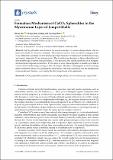Formation mechanism of CaCO3 spherulites in myostracum layer of limpet sahells
Abstract
CaCO3 spherulites were found in the myostracum layer of common limpet shells collected from East Sands, St Andrews, Scotland. Their microstructures were revealed by using powder X- ray diffraction, scanning electron microscopy, high resolution transmission electron microscopy, and energy dispersive X-ray microanalysis. The formation mechanisms of these spherulites and their morphology evolution were postulated. It was proposed that spherical particles of an inorganic and biological composite formed first. In the centre of each spherical particle was developed a double-layer disk of vaterite crystal sandwiching a biological sheet. The disk crystal supplies a relatively strong mirror symmetric dipole filed, guiding the orientations of the nanocrystallites and the arrangement of mesorods, and therefore, determining the final morphology of the spherulite.
Citation
Wu , S , Chiang , C-Y & Zhou , W 2017 , ' Formation mechanism of CaCO 3 spherulites in myostracum layer of limpet sahells ' , Crystals , vol. 7 , no. 10 , 319 . https://doi.org/10.3390/cryst7100319
Publication
Crystals
Status
Peer reviewed
ISSN
2073-4352Type
Journal article
Description
The authors would like to thank EPSRC for financial support on FEG-SEM equipment (EP/F019580/1) and FEI Scios dualbeam microscope (EP/L017008/01).Collections
Items in the St Andrews Research Repository are protected by copyright, with all rights reserved, unless otherwise indicated.

